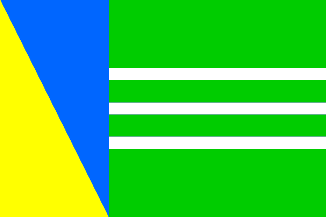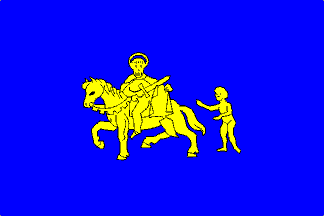 Shipmate Flagchart : http://www.flagchart.net
Shipmate Flagchart : http://www.flagchart.net
Adopted 24 Feb 1978; design: unknown.

Last modified: 2018-12-15 by rob raeside
Keywords: bergen op zoom |
Links: FOTW homepage |
search |
disclaimer and copyright |
write us |
mirrors
 Shipmate Flagchart : http://www.flagchart.net
Shipmate Flagchart : http://www.flagchart.net
Adopted 24 Feb 1978; design: unknown.
Flag: three stripes of red and white, proportioned height-wise 1:2:1,
with on the white stripe the full municipal arms.
Adopted by municipal resolution 24 Feb 1978; design: unknown.
Originally the town's colors were chequy black and white. In the 19th
century white and red were considered as town-colors. The present flag
dates from c. 1870. A modernized version is in use by the municipality
of Bergen op Zoom.
Source: DerkWillem Visser: Gemeentevlaggen en wapens Koninkrijk
der Nederlanden", 2001.
Sierksma's Nederlands Vlaggenboek, 1962, notes that that flag
was not used anymore, but that its restoration was commendable.
Jarig Bakker, 26 May 2005
Bergen op Zoom is located in the middle of woods. The sandy soil of
the neighbirhood is grown with asparagus. Bergen op Zoom was in 1287 the
main city of an important independent lordship. There were to fairs per
year in the city in the Middle Ages. The ancient port, today partially
silted, was linked to the Eastern Schelde. In 1533, the lordship of Bergen
op Zoom became a Marquisate.
The city has remained famous as unconquerable; in 1588, the Spanish
troops commanded by Duke of Parma Alexander Farnese could not seize it;
neither could Spinola in 1622.
The Frisian military engineer Menno van Coehoorn (1641-1704) increased
the fortifications of the city around 1700. However, the city was seized
by the French in 1747, during the War of Spanish Succession. The fortifications
were demolished in 1868 but are recalled by large avenues.
The municipal arms can be seen on the facade on a house built in 1611
on the Great Square (Grote Markt) of the city. They show two savages
flanking a shield surmonted by a Marquis' crown. The shield shows
three white crosses and a three mounts, canting for the name of the city
(Berg = mount).
The former palace of the Marquis of Bergen op Zoom (Markiezenhof),
built by Antoine Keldermans in the XVth-XVIth century, was inhabited by
the Marquis until 1795. It is today a cultural center, including the municipal
museum, which shows, inter alia, procession banners.
Source: Guide Vert Michelin Hollande.
Ivan Sache, 27 May 2005
![[Bergen op Zoom other flag]](../images/n/nl-nb_bz.gif) by Jarig Bakker, 26 May 2005
by Jarig Bakker, 26 May 2005
According to "Wie, Wat, Waar? 1940", an annual published by the
Rotterdamsch Nieuwsblad in Nov. 1939, the flag of Bergen op Zoom was: horizontal
white over red.
Jarig Bakker, 26 May 2005
bz.gif) International
Civic Arms : http://www.ngw.nl/
International
Civic Arms : http://www.ngw.nl/
Arms: gules three saltires argent, placed 2,1, in base a threemountain
vert; the shield surmounted by a crown or of five leaves, and supported
by two wild men.
Granted 16 Jul 1817.
Jarig Bakker, 26 May 2005
 Shipmate Flagchart : http://www.flagchart.net
Shipmate Flagchart : http://www.flagchart.net
Description: the hoist divided by a hoist diagonal blue over yellow;
the fly with seven stripes of green and white, proportioned 6:1:2:1:2:1:6.
In the hoist the traditional division for St. Martin has been represented
in the colors in which he is designed on the municipal arms. The
hoist and its division is analogous to the flag of Woensdrecht.
Three white stripes on green correspond to the three silver mascles on
green of the municipal arms.
Furthermore on can see:
- the three main villages before it was incorporated into France, beginning
of the 19th century
- the present villages Halsteren, De Poort and Lepelstraat
Source: Vexilla Nostra 129.
 Shipmate Flagchart : http://www.flagchart.net
Shipmate Flagchart : http://www.flagchart.net
Description: In blue St. Martin on a horse with beggar, the saint cutting
off part of his coat; the whole image in yellow, all of 1/2 flaglength
and 1/2 flagheight.
The flag represents the top half of the municipal arms.
However in practice the flag was not satisfactory.
Source: Vexilla Nostra 129.
![[Halsteren Coat of Arms]](../images/n/nl-nb)ht.jpg) image from this website.
image from this website.